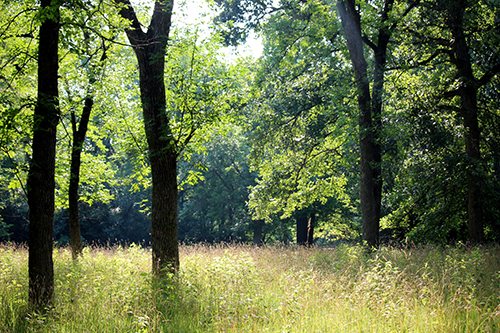 Purdue University - Extension - Forestry and Natural Resources
Purdue University - Extension - Forestry and Natural Resources
Got Nature? Blog
 What you do on your property is your choice first and foremost. I commonly get questions or comments related to the need to manage one’s property rather than setting the land aside and let nature take its course. One is not necessarily better than the other, but the outcomes will likely be very different. Certainly keeping land in a more ‘natural’ state provides better habitat for wildlife compared to a parking lot – both scenarios above achieve this. However, there are several reasons why you should at least consider a more active management approach.
What you do on your property is your choice first and foremost. I commonly get questions or comments related to the need to manage one’s property rather than setting the land aside and let nature take its course. One is not necessarily better than the other, but the outcomes will likely be very different. Certainly keeping land in a more ‘natural’ state provides better habitat for wildlife compared to a parking lot – both scenarios above achieve this. However, there are several reasons why you should at least consider a more active management approach.
The way our landscape is configured now is different from long ago so we can’t expect processes to function the same way as they once did. Setting land aside for preservation often has the goal of letting the land return to pre-settlement conditions. While looking into our past can help inform management decisions, it doesn’t make much sense biologically to completely rely on this approach. At what point in time should it be? Remember, part of the Indiana was covered by glaciers and flocks of passenger pigeons (now extinct) numbering in the billions used to call Indiana home. Just think about what your car looks like after parking under a tree occupied by a few dozen starlings – imagine what billions of birds roosting do to tree limbs and the soil nutrient levels. Moreover, natural processes, or wildlife responses to them, may not be desirable. For example, having too many deer or raccoon may be problematic.
Invasive species have also completely changed the way we view habitat management. Their control requires regular monitoring and appropriate control measures, preferably before they become overabundant. Simply letting nature take its course can have unintended, and undesirable, consequences. Setting land aside is certainly one option to consider. Just don’t be mistaken that approach is best for wildlife and our natural resources.
I would argue it is better to inventory what you have on your property, identify what you want out of your land out of potential options, and then determine the approach that meets these objectives.
To learn more about this active style of property management, read Wildlife Extension Specialist Brian MacGowan‘s publication “Assessing Your Land’s Potential for Wildlife.”
Resources:
Assessing Your Land’s Potential for Wildlife – The Education Store, Purdue Extension Resource Center
Woodland Wildlife Management – The Education Store
Managing Forest & Wildlife Resources: An Integrated Approach – The Education Store
Forest Management for Reptiles and Amphibians: A Technical Guide for the Midwest – The Education Store
How to Construct a Scent Station – Purdue FNR Extension
Brian MacGowan, Extension Wildlife Specialist
Purdue Department of Forestry and Natural Resources

Recent Posts
- Report Spotted Lanternfly – Purdue Landscape Report
Posted: April 10, 2024 in Alert, Forestry, Invasive Insects, Plants, Wildlife, Woodlands - Declining Pines of the White Variety – Purdue Landscape Report
Posted: in Alert, Disease, Forestry, Plants, Wildlife, Woodlands - Are you seeing nests of our state endangered swan? – Wild Bulletin
Posted: April 9, 2024 in Alert, Forestry, How To, Wildlife - Cicadas in Spring! – Purdue Landscape Report
Posted: in Forestry, Plants, Safety, Wildlife - New Deer Impact Toolbox
Posted: April 7, 2024 in Forestry, Land Use, Plants, Publication, Safety, Wildlife, Woodlands - 2024-25 Fishing Guide now available – Wild Bulletin
Posted: April 4, 2024 in Alert, Aquaculture/Fish, Aquatic/Aquaculture Resources, How To, Ponds, Wildlife - Help Research Chronic Wasting Disease – Wild Bulletin
Posted: April 3, 2024 in Disease, Forestry, How To, Safety, Wildlife, Woodlands - Indiana Reptiles and Amphibians – IFWOA Webinar
Posted: April 1, 2024 in Forestry, How To, Webinar, Wildlife, Woodlands - Birding through the Seasons – IFWOA Webinar
Posted: in Forestry, How To, Webinar, Wildlife, Woodlands - Look Out for Invasive Carp in Your Bait Bucket – Wild Bulletin
Posted: March 31, 2024 in Alert, Aquaculture/Fish, Aquatic/Aquaculture Resources, Invasive Animal Species, Wildlife
Archives
Categories
- Alert
- Aquaculture/Fish
- Aquatic/Aquaculture Resources
- Ask the Expert
- Christmas Trees
- Community Development
- Disease
- Drought
- Forestry
- Forests and Street Trees
- Gardening
- Got Nature for Kids
- Great Lakes
- How To
- Invasive Animal Species
- Invasive Insects
- Invasive Plant Species
- Land Use
- Natural Resource Planning
- Nature of Teaching
- Plants
- Podcasts
- Ponds
- Publication
- Safety
- Timber Marketing
- Uncategorized
- Urban Forestry
- Webinar
- Wildlife
- Wood Products/Manufacturing
- Woodland Management Moment
- Woodlands